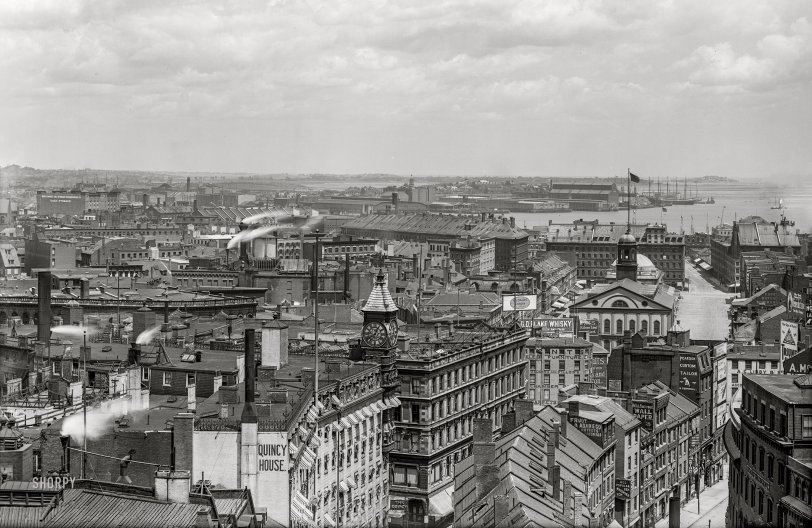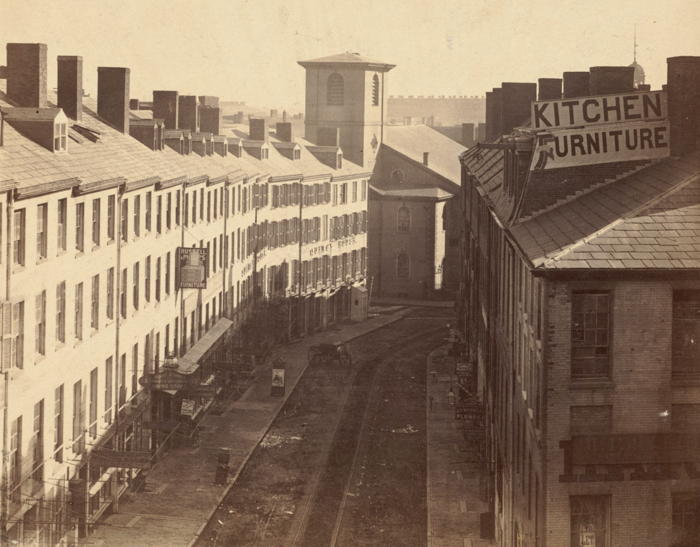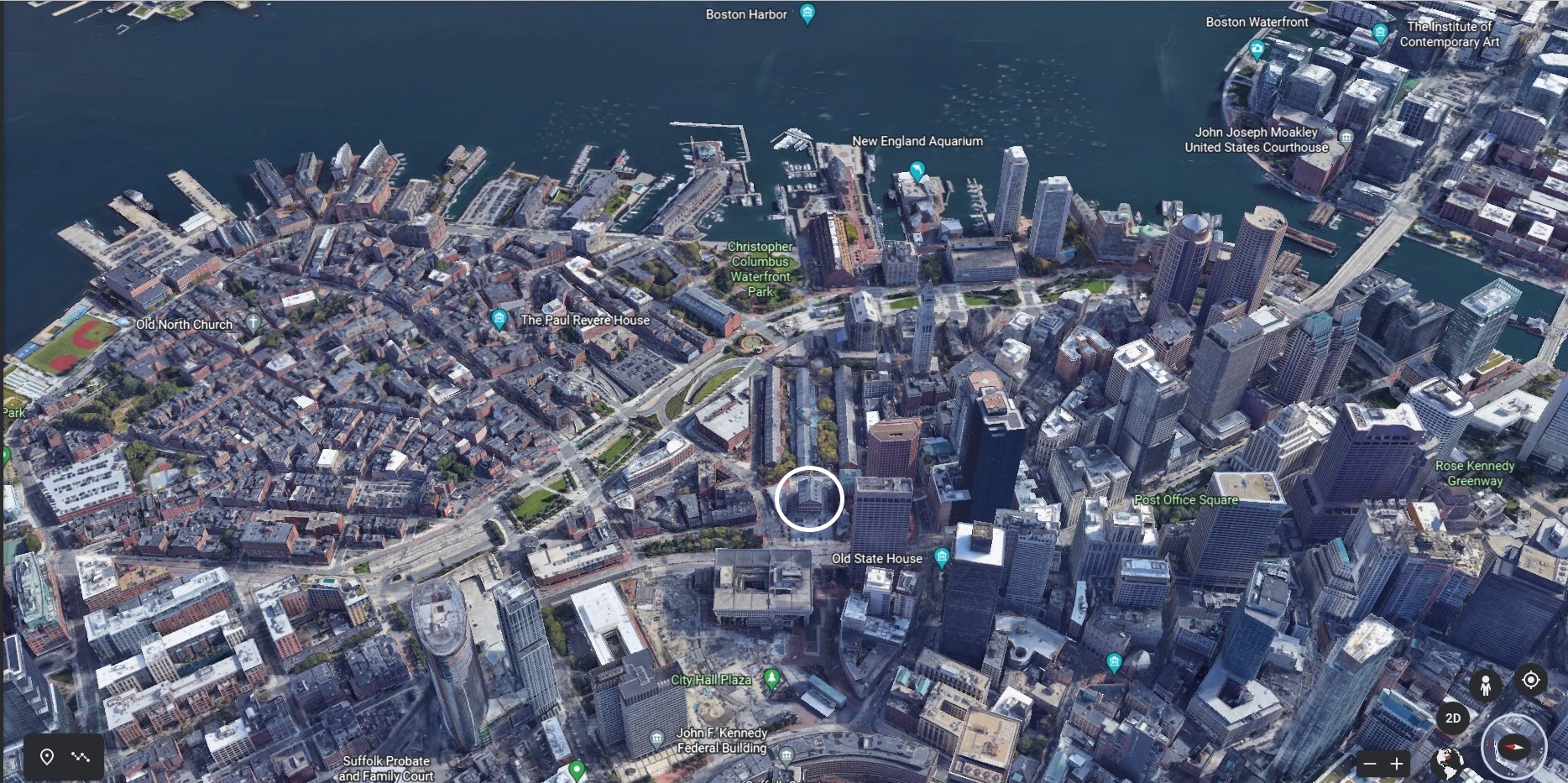


Framed or unframed, desk size to sofa size, printed by us in Arizona and Alabama since 2007. Explore now.
Shorpy is funded by you. Patreon contributors get an ad-free experience.
Learn more.

- Details, Details
- What's that building to the left of the tower?
- Coal Barges
- Bromo-Seltzer
- Inner harbor
- The Basin
- What a headache!
- Giant stepladder?
- Baldwin 62303
- Baldwin VO-1000
- Cold
- No expense spared
- Tough Guys
- Lost in Toyland
- And without gloves
- If I were a blindfolded time traveler
- Smoke Consumer Also Cooks
- Oh that stove!
- Possibly still there?
- What?!?
- $100 Reward
- Freeze Frame
- Texas Flyer wanted
- Just a Year Too Soon
- WWII -- Replacing men with women at the railroad crossing.
- Yes, Icing
- You kids drive me nuts!
- NOT An Easy Job
- I wonder
- Just add window boxes
Print Emporium
Boston Rooftops: 1906

Boston circa 1906. "Quincy House and Faneuil Hall from Barrister's Hall, Boston University." 8x10 inch dry plate glass negative, Detroit Publishing Company. View full size.
Survivors
As noted below, Faneuil Hall, in the center of the photo, with the low-pitched roof, cupola, and half-moon window in the gable, is still there, as is the central Quincy Market building immediately behind it, with the large. light-colored dome. Today, Quincy Market is a big food court, filled with tourists, asking for directions to Fenway Park. (Umm, kind of a long walk from here.) The long line of buildings to the immediate left of Quincy Market, with the street level awnings, is also still there - part of the Quincy Market commercial development - consisting largely of shops and places to eat and drink. The stone building immediately behind Quincy Market is long gone, but the long 5-6 story stone building immediately to the left of it is Mercantile Wharf. The front section of Mercantile Wharf has been lopped off, but the rest of it is still there - commercial space at street level, pricey condos above. Finally, the building in the extreme lower right corner of the photo, with "Sears Crescent" written in stone on the face, is still there (as is the original stone "Sears Crescent" signage). But virtually everything to the left of that building is gone, replaced by the barren, windswept desert of City Hall Plaza, and the brutalist concrete architecture of City Hall itself. They keep trying to liven it up, with only limited, incremental success.
Great picture of a great city. (Excuse me now while I go get a 10 cent whiskey in that fine establishment across the street from the Sears Crescent.)
One Other Still Standing
The Sears Crescent Building on the far right still stands, I believe. The building was given that shape to follow Cornhill Street, which no longer exists.
I'm not old enough to remember when the neighborhood looked like this. However, I am old enough to remember it in the early 1960s, flat and empty.
Shorpy has visited other nearby sites, like Adams Square (https://www.shorpy.com/node/7919), also obliterated in haste and regretted at leisure.
Cold makes things grow, too
As in the operations of the Quincy Market Cold Storage and Warehouse Company. Beginning with a warehouse at Commercial and Richmond Streets (situated behind the ball of the Quincy House's flagpole) it expanded up the street to that hulking building near the left of the photo (which ended up looking even more hulking); all linked together by a "maze of insulated metal pipes coiling for 30 miles under the cobblestone streets".
Faneuil Hall Marketplace survives
The building in the 1906 photo with the pitched roof and copula survives. It appears all else is no more. City Hall Plaza has replaced most of what is in the foreground.
Click to embiggen. Faneuil Hall Marketplace is circled in white.
[NOTE: Must be 18 or older to enter the "copula." - Dave]
Dave, I'm too ashamed to admit how many times I Googled "copula" after your comment and got the correct response of cupola without noticing Google corrected my spelling. Yes, "copula" is something very different.
Vanished Boston institutions
The Quincy House lasted eleven decades after it opened on the corner of Brattle Street and Brattle Square around 1819. The photo below, circa 1860, shows it before an 1885 expansion to seven stories and 500 rooms--Boston's largest hotel.
Across the street in the earlier photo is square-towered Brattle Street Church, erected in 1772. As is clear from the Shorpy photo, the hotel outlasted the church, which was demolished when the congregation moved to Back Bay in 1872--then disbanded four years later. The Quincy House closed in 1929.
Even the addresses are gone. Ask for Brattle Street and Brattle Square today, and you'll end up in Cambridge.

What Could Have Been
So much of this Boston cityscape was obliterated by urban renewal in the late 1950s and early '60s and replaced with soulless concrete and glass monstrosities. Restoration and repurposing could have made the city far less of an eyesore than this area is today.
Where's my shopping cart???
Everything you need is there. Whiskey, rifles and pistols, art supplies, sign makers...you name it, it's there. And speaking of there, could that 5-masted schooner shown there in the picture just to the right of the tallest flag pole be the "Jane Palmer"? Hard to say, but it could be

























On Shorpy:
Today’s Top 5